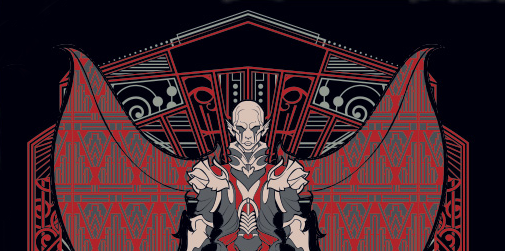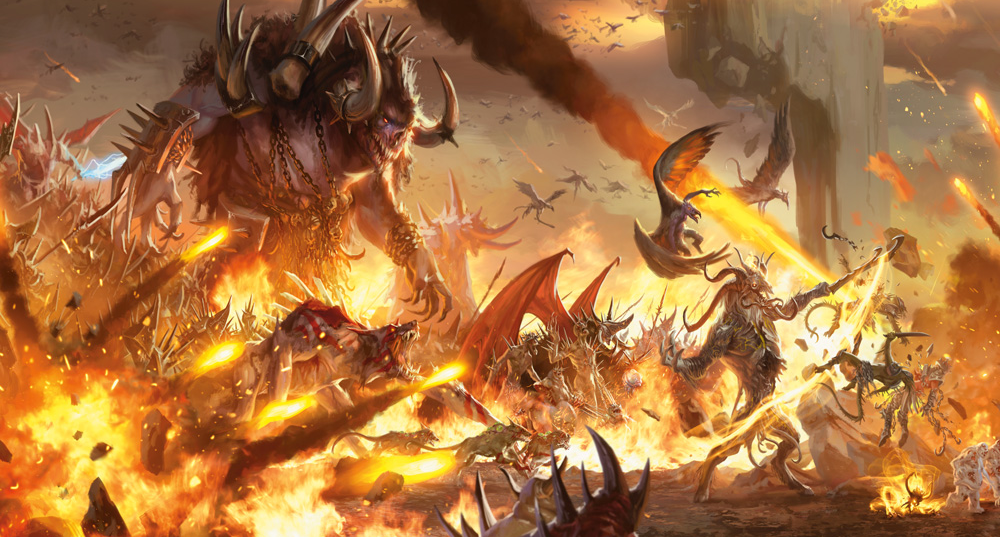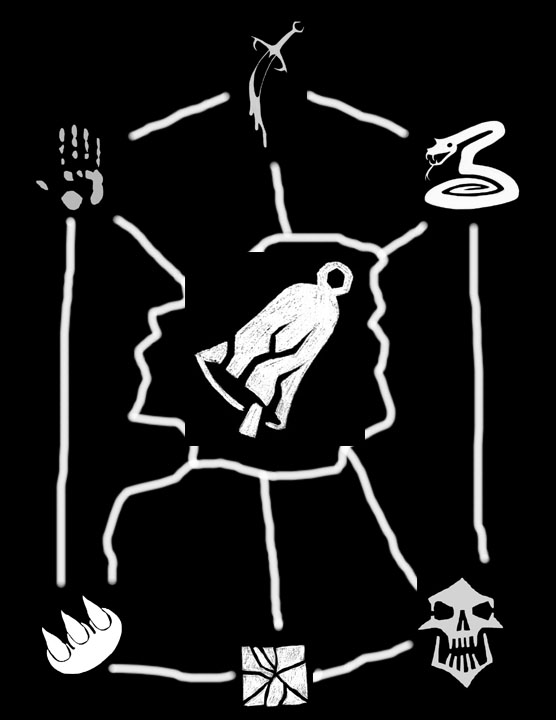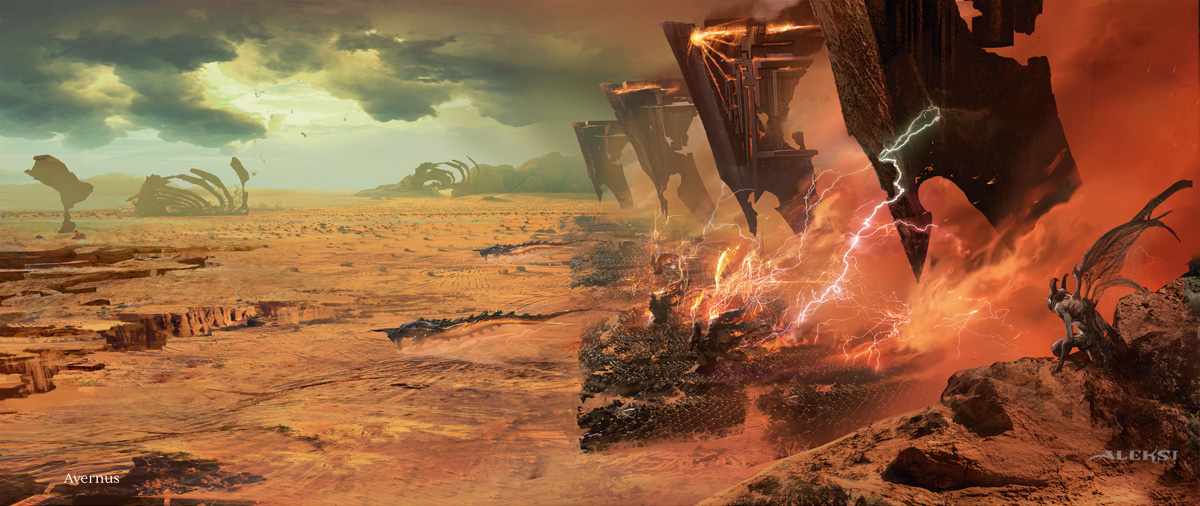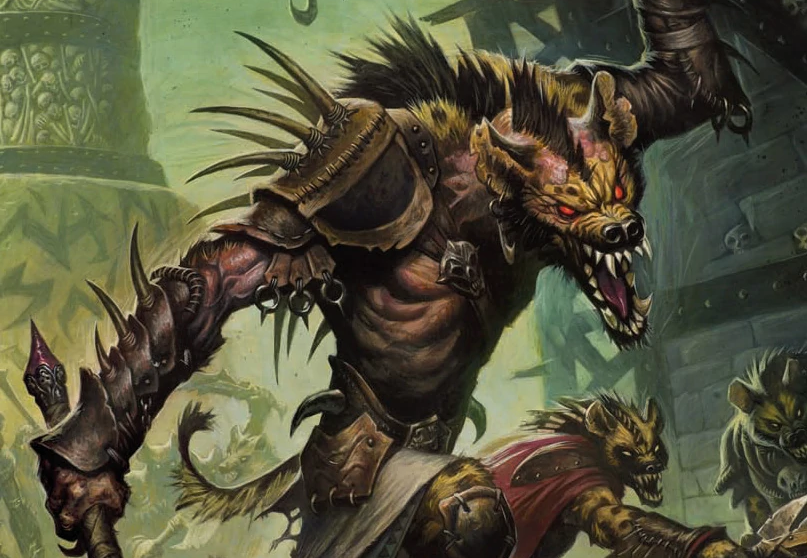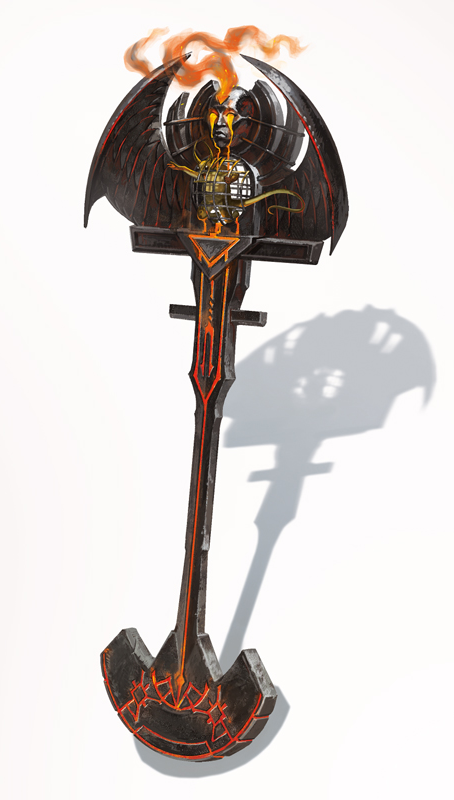THE FALL OF ZARIEL
- When the battle at last came to an end, Baalzephon was astonished to see Asmodeus himself arrive.
- They found Zariel beneath a mound of devils she had slain. She was badly injured, but still lived. As she awoke, Asmodeus knelt beside her in the dust of Avernus. He spoke to her in a soft voice.
I look at you and I see that you are in despair. You thought you could make a difference. That you could end the Blood War. But here you are on a field of dead friends.
You look at me and I know you see malevolence. You see Evil. You see an antithesis. You see betrayal. But I did make a difference. And I will end the Blood War.
All those aeons ago, at my trial, when I looked you in the eye and laughed. Do you think I mocked you? No. I laughed because I saw you standing where I had stood before. I knew we walked the same road and you were just a few steps behind me.
Look around you. Look at the dead. Piled high. Do you really think this to be Good? Do you think this butchery to be worthwhile because it was done in a noble cause? You know as well as I do that as long as this continues, as long as the dead are nothing but tallies in the ledgers of complacent gods, Good is derelict. It is meaningless. It is feathery cupids cavorting on a celestial isle while suffering boils forth across the multiverse.
I know you came here to kill demons. You think you have failed. I think you have barely begun.
Which of us do you think sees more clearly?
What I offer you is simple: A chance to continue our fight. You have killed Terza’reg. I offer you his place on the Dark Eight and command of a Blood Legion. Serve me and your Crusade can still boil across the Abyss and turn the Great Wheel into a new epoch.
- In truth, the two conversed on many different planes of thought. And, in the end, Zariel accepted Asmodeus’ offer, swearing fealty to him and accepting his commission as one of Bel’s generals. Perhaps Asmodeus was right. Or perhaps she had been right to fear her weakness. Or perhaps in her pride, she convinced herself that, once she had dealt with the Abyss, she would be able to turn on Asmodeus and save Hell from itself.
- But Zariel had fallen.
- Haruman willingly followed Zariel in swearing allegiance to Asmodeus. Olanthius chose to commit suicide instead, but even in death discovered that he was bound by his oath to “crush the evil of the Abyss under the guidance of Zariel” and was raised as a death knight in her thrall.
Note: Once again, kids, examine the fine print of your oaths.
LULU: HIDING THE SWORD
- Yael and Lulu did not have any method for immediately fleeing the Outer Planes. In fact, they were essentially lost: Lulu had never been to Avernus before and the Zarielites had been preparing for an invasion of the Abyss, not the Nine Hells. However, part of those preparations had included learning the location of a number of pan-dimensional bolt-holes in the Abyss.
- Their plan, therefore, was to reach the Styx and use the river to travel into the Abyss and – if they got extremely lucky – find a way out. (If the plan failed, then perhaps they could throw the Sword of Zariel into the Styx to keep it out of Hell’s hands.)
- Lulu knew there would be Avernian watchposts along the length of the Styx. Penetrating that defensive line would be difficult. But Yeenoghu’s army must have crossed it somewhere and somehow, so they decided to backtrack his army and hope to duplicate his success.
- The plan worked: They discovered that Yeenoghu’s army had taken out three of the Styxian watchposts, leaving a gaping hole in the defensive line. They managed to cross the Styx and then commandeer an infernal ferry from a charonadaemon.
Note: At this time during the Blood War, the demons of the Abyss had successfully captured the far shore of the Styx. Their war palaces were bastions of war and the heavily fortified banks of the Styx were a muddy mire of endless, bloody war that extended into astral trenches.
- What they didn’t know was that Yeenoghu was tracking the Sword of Zariel. A war party waylaid them. With their ferry sinking, Yael and Lulu were forced back into Avernus.
- Pursued by Yeenoghu and with the forces of Hell closing in as well, Yael and Lulu realized that there was no escape. Yael plunged the Sword of Zariel into a rock and called for divine intervention. Lulu poured her own celestial essence into the call, the sympathetic resonance of her trumpet echoing across the Avernian plains as she drove Yael’s plea across the planes. Even so, the gods could wield little power in Avernus, but Lathander gave them an opportunity. Yael sacrificed herself, pouring her life force into what Lathander offered, raising an alabaster fortress around the Sword to protect it.
- The skein of Avernus itself rebelled at this holy touch, however, and a bloody cyst engulfed the fortress, Yael’s corpse, and Lulu.
ZARIEL IN HELL
Zariel became one of the Dark Eight, a general serving Archduke Bel. She frequently rebelled against Bel’s commands, however, pursuing far more aggressive strategies. Her Blood Legion was preternaturally successful, sacking numerous daemonic war palaces and establishing a beachhead on the far side of the Styx.
THE RECKONING (13th Century DR): The Reckoning was a tri-partite conspiracy masterminded by Glasya, daughter of Asmodeus. She managed to convince half the Lords of Hell that the other half were planning a rebellion and vice versa. The third conspiracy consisted of Glasya, Zariel, and Malagard the Hag Countess (who was a councilor to Moloch, Lord of the Sixth), who believed they could seize considerable power for themselves as the Lords warred against each other. (Glasya even had aspirations of overthrowing her father and claiming Hell for herself.)
- The trigger point for the Reckoning came when Bel was targeted by a demonic assassin. The attack failed, leaving Bel in a magical coma. Evidence pointed to Dispater, Archduke of Dis, the second level of Hell. (In reality, the “assassination” was actually arranged by Glasya and had exactly the intended effect.)
- Zariel, having forged an alliance with Tiamat, laid siege to Dis. (Tiamat not only gave Zariel safe passage to the second level of Hell, but also threw her own draconic legions into the fray.)
- The full details of the Reckoning are beyond the scope of this project. Zariel spent almost the entire war engaged in the siege of Dis.
- Near the end of the Reckoning, Tiamat betrayed Zariel. The siege of Dis was broken and Zariel ended up being held a prisoner in Tiamat’s dungeons.
- Glasya and Malagard had convinced Moloch, Lord of Malbolge, to pursue a scheme to use the chaos of the Reckoning to dethrone Asmodeus. It failed, but Glasya was able to use this as a framework to frame Moloch as the “mastermind” behind many of her own schemes. Moloch was deposed by Asmodeus and Malagard raised in his place. (Malagard herself was recently killed by Glasya, who has become Archduchess of Malbolge herself.)
Design Note: Placing the Reckoning in the 13th century and ending it with Zariel as Tiamat’s prisoner allows us to preserve a lot of pre-DIA continuity that DIA’s retcons had wiped out. For example, all of Bel’s pre-DIA continuity remains intact (except that he now supplants Gargauth, not Zariel, to become Lord of Avernus). Zariel still gets to besiege Dis to begin the Reckoning. And the imprisonment of Zariel by Tiamat (as described in Rise of Tiamat) is also slotted into place.
THE RIFT WAR (15th Century DR): The surface of Avernus is periodically rent with massive rifts. Similar to rift valleys of the Material Plane, they are formed by the surface of Avernus pulling itself apart. But while some proceed with a glacial pace, others can appear with terrifying, convulsive speed.
There are many metaphysical theories about the nature of these rifts: Perhaps Avernus is like a “cap” which Asmodeus placed upon the Nine Hells, but Hell keeps trying to expand, trying to push its way through the planar substrate. Or Avernus itself is constantly expanding like a cancerous tumor, with the rifts either being where that new growth pushes out new planar material and/or where Avernus is trying to break apart, “budding” off new planes. Or they’re manifestations of demi-planes, either attaching themselves like parasites to Avernus or being forcibly scooped up by Hell’s vortex. Some even postulate they could be the spirits of evil living demi-planes that have died and are manifesting, lemure-like, in Hell. Or perhaps they are simply another hellish expression of Avernus’ corrupt landscape.
Whatever the case, in the early 15th century a rift of unprecedented size rapidly opened on the contested side of the Styx.
And it was seething with baatorians.
Baatorians were the original inhabitants of Hell. They had a unique life cycle: Their larval state (known as nupperibo) were spontaneously generated out of the substance of Hell itself as a sort of tubercular reaction to the arrival of an evil soul. As Hell expanded, this strange property seemed to extend to each new level. Over time, the nupperibo could ascend into higher forms (in a process referred to as “molting”). For untold aeons, they were the factious rulers of Hell.
The ultimate fate of the baatorians has been lost to legends older than mortal civilization: Some claim that the entire species ultimately ascended into forms of pure energy – stories speak of “strange lights” and “malevolent shadows” – leaving Hell uninhabited when Ahriman arrived. Others claim that Ahriman conquered the baatorians and wiped them out in a genocide of colossal proportions.
Whatever the case may be, it seems fairly certain that Ahriman fundamentally reworked the cosmology of Hell, somehow adapting the baatorian ecology to instead generate lemures, the larval state of the baatezu devils. (It’s possible this is somehow connected to the rerouting or creation of the River Styx, a transport mechanism for mortal souls from which many lemure emerge.) Nupperibo are still known to manifest from the firmament of Hell, but they are usually ruthlessly hunted down and destroyed by the devils before they can molt into the more advanced forms of their species.
Now, however, an entire army of baatorians boiled out of the rift – some strange redoubt or primeval throwback of the ancient race – and invaded Avernus.
- Bel blew it. He had left most of the war palaces Zariel had conquered vacant and the baatorians were able to seize them for their own use. The defensive lines of the blood legions, having been thoroughly disrupted, collapsed and were routed. Watchtowers along the Styx were overrun and destroyed. For the
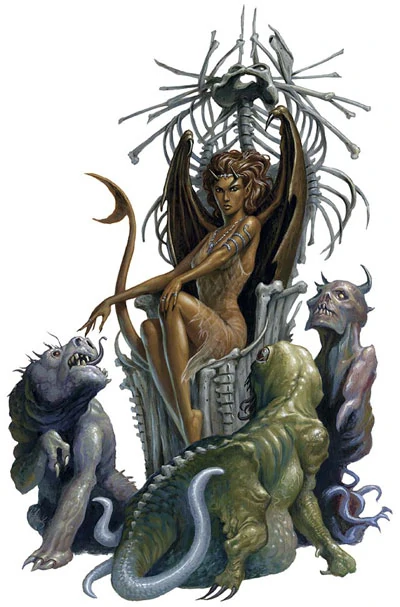 first time in centuries, the Avernian frontiers were in utter disarray. Although no alliance was formed between the baatorians and demons, armies of both races freely crossed the Styx.
first time in centuries, the Avernian frontiers were in utter disarray. Although no alliance was formed between the baatorians and demons, armies of both races freely crossed the Styx. - With the “Avernian situation” rapidly deteriorating, Glasya saw an opportunity. She journeyed to Tiamat’s citadel and arranged for Zariel’s release. (There are several stories of how she accomplished this: A secret deal with Tiamat. Delivery of an edict from Asmodeus himself. A daring jailbreak heist.)
- Zariel’s Second Avernian March: For a second time, Zariel began a march across Avernus. This time, rather than fleeing, Zariel was gathering the scattered, routed units of the blood legions. As Bel retreated, Zariel attacked. She forded the Styx, re-sacked the war palaces she had first claimed two centuries earlier, and broke the baatorian supply lines. Then she turned around, marched back to the Styx, and intercepted the baatorians’ main army as it was attempting to cross the river. In the bloody, muddy Battle of Lost Memories, the baatorians’ strength was broken.
- The Rift Siege: After the Battle of Lost Memories, Zariel was able to link up with Dagos and Furcas, two of the Dark Eight whose armies had been cut off, and re-established the defensive watchposts along the Styx. While Dagos and Furcas held the river, effectively dividing the remaining baatorian forces in half, Zariel led her army to lay siege to the Rift. Once the Rift fell, the war was essentially over.
- The Archduchess: Asmodeus punished Bel for his failure by demoting him back to the ranks of the Dark Eight. In Bel’s place, he elevated Zariel as the new Archduchess of Hell.
Note: This history covers the broad strokes of Zariel’s life after her fall. For additional events directly relevant to Descent Into Avernus, refer to the “Lore of Gargauth” in Part 3B and “The History of Elturel’s Fall” in Part 4B.
LULU LEAVES HELL
- Although Lulu had been caught inside the bloody cyst, over the intervening centuries she had been slowly getting pushed out – like a sliver from your foot. She awoke – dazed and confused – upon the scabrous surface of the cyst and wandered away. (This was most likely during the time that Zariel was imprisoned in Tiamat’s dungeons.)
- During her wanderings, she visited Fort Knucklebones.
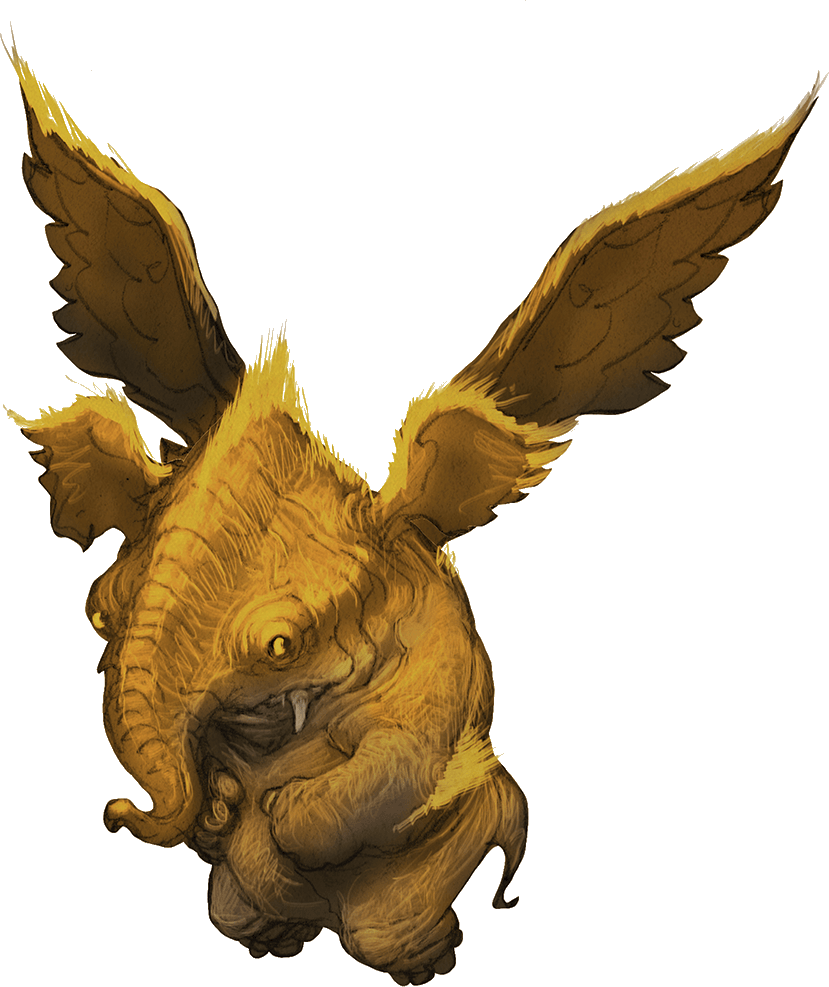 [You could potentially insert other memories of Avernian landmarks here.]
[You could potentially insert other memories of Avernian landmarks here.] - Lulu encountered the Wandering Emporium. There she was tricked by a rakshasa named Mahadi, who splashed her with water from the river Styx. Keeping her thus in a constant stupor, he kept her imprisoned. (A hollyphant’s tusks can be ground into a magical powder that transforms water or wine into an elixir of health. Mahadi kept her essentially drugged and senseless so that he could repeatedly grind down her tusks.)
- When Zariel became the new Archduchess of Avernus, Mahadi brought Lulu to her court and presented her as a gift. Zariel was disappointed to discover that Lulu was suffering from Styxian memory loss, for she wanted to recover her Sword, but had fond memories of her old friend. She gave orders that Lulu should be returned to Mount Celestia and dispatched a small party of devils to see it done.
- While crossing Avernus to an appropriate gate, Lulu’s devil escorts were ambushed by the warlord L’zeth (DIA, p. 90). Lulu, still in a Styxian befuddlement, wandered away from the scene of the ambush.
- Some time later, the effects of the water of the Styx finally wore off. (This is the beginning of Lulu’s memories.) She came to the River Styx shortly thereafter and followed it out of Avernus, journeying through the Outer Planes and having many adventures along the way.
- She eventually ended up in the Nexus (see Book of Eldritch Might III) and passed through a portal which took her to the city of Neverwinter in 1488 DR. From there she made her way south, returning to the area around Elturel. There she either becomes a PC (as described in Part 2) or met Sylvira (as described in Part 4C).

